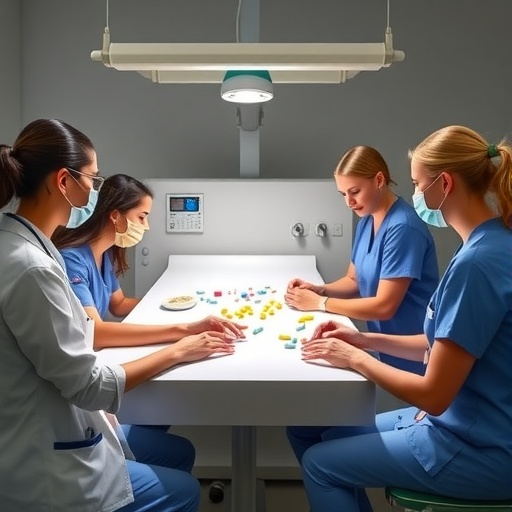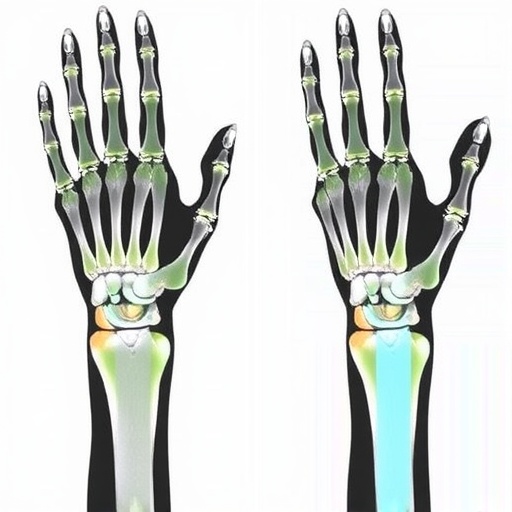
A recent study has uncovered a compelling association between physical performance and daily activity metrics in older adults grappling with frailty and sarcopenia. The research, led by experts such as J. Rogler, S. Krumpoch, and E. Freiberger, brings to light the significance of the 400-meter walk test as a reliable indicator of sensor-based daily physical activity. This research adds a vital dimension to our understanding of geriatric health and the challenges faced by aging individuals.
Sarcopenia, characterized by the progressive loss of muscle mass and strength due to aging, presents a notable health concern. Frailty often accompanies this condition, resulting in reduced resilience to stressors and increased vulnerability to adverse outcomes. These interconnected conditions can severely impair mobility and quality of life in older adults, making effective assessments of physical performance crucial. This paper not only highlights the 400-m walk test but also explores its relationship to technological assessments of daily activities.
The methodology of the study involved a cohort of frail and sarcopenic older adults who underwent both the 400-meter walk test and monitoring through wearable sensor devices. The wearable sensors provided a comprehensive snapshot of the participants’ daily activity levels, capturing data that extend beyond mere steps taken. This combination of assessing physical performance through the walk test and correlating it to detailed sensor data represents a significant advancement in geriatric research techniques.
Results indicated that there is indeed a positive correlation between the performance on the 400-meter walk test and the levels of daily physical activity recorded by the sensors. Notably, those who performed better on the walk test tended to engage in higher levels of overall physical activity. This finding emphasizes the potential of the 400-meter walk test as a simple, yet effective screening tool for determining the activity levels of frail and sarcopenic individuals in a clinical setting.
The implications of these results are far-reaching. Healthcare professionals can utilize the 400-meter walk test not only to gauge the mobility status of an older adult but also to predict their daily activity levels. This could lead to more tailored and effective interventions aimed at boosting physical activity among older adults, who often face barriers to remaining active due to mobility issues. The potential to enhance quality of life and independence among this demographic is a significant takeaway from the study.
Furthermore, the study’s findings also advocate for the integration of technology in geriatric assessments. With the increasing prevalence of wearable technology, clinicians could employ these devices to gather quantitative data on an individual’s daily movement patterns. Such technology aids in the identification of patients who may need additional support to increase their physical activity levels. The synergy between traditional testing methods and technological innovations could pave the way for enhanced patient-centered care.
One of the most promising aspects of the study is its potential to inform public health policies. As societies grapple with aging populations, understanding the relationship between physical performance metrics and daily activity can assist in developing initiatives aimed at improving the health outcomes of older adults. By focusing on interventions that promote physical activity, communities could work towards reducing the prevalence of sarcopenia and frailty and their associated health risks.
In conclusion, the research by Rogler, Krumpoch, and Freiberger sheds light on an important issue facing aging adults. It underscores the value of the 400-meter walk test as a reliable tool for assessing daily physical activity, ultimately highlighting the critical intersection of physical performance and technology in geriatric healthcare. As the field continues to evolve, studies like this one will remain instrumental in propelling forward our understanding of physical activity and its essential role in aging well.
Furthermore, the push for further research is paramount. Larger studies with more diverse populations will help verify these findings and potentially expand them across different contexts. As healthcare continues its transition into a more precision-oriented approach, understanding the markers and correlates of frailty and sarcopenia will be vital for developing appropriate strategies aimed at aging populations.
In closing, the implications of this study are not just limited to clinical assessments; they extend into the realms of technology integration, public health, and individual care strategies. The relationship defined between the 400-meter walk test and daily sensor-based activity levels unveils avenues for more effective management of frail and sarcopenic older adults, contributing to better health outcomes and an improved quality of life.
The ongoing discourse around aging, mobility, and health remains dynamic, prompting continuous examination and adaptation of our approaches towards aging populations. These insights beckon the medical community to adopt more holistic views in assessing and treating older adults, ultimately fostering a society that values not just longevity, but the quality of life that accompanies it.
Strong implications for practice and policy also stem from this research. By placing emphasis on mobility assessments and daily activity levels, care models can evolve. The integration of such assessments into routine healthcare practices might be pivotal in shifting the paradigm from reactive to proactive care.
Research findings like those from Rogler et al. serve not only to inform clinical practice but also to empower patients. By equipping older adults with the knowledge of how their physical performance relates to their daily activity levels, we can encourage more active lifestyles, fostering a culture of health that transcends age.
In the larger context, staying physically active shouldn’t be seen merely as a measure of fitness but rather a foundational pillar of healthy aging. As research continues to shed light on the intricate connections between mobility, activity levels, and overall health, the narrative surrounding aging must adapt to prioritize and celebrate the active engagement of older adults in their health journeys.
By advocating for the understanding of these complex relationships, the efforts to combat frailty and sarcopenia can be very much supported. The call to action is clear: we must invest in our older adults, promote mobility, and harness both traditional assessment methods and modern technology to ensure healthier aging for all.
Subject of Research: The relationship between the 400-meter walk test and daily physical activity in frail and sarcopenic older adults.
Article Title: Association between the 400-m walk test and sensor-based daily physical activity in frail and sarcopenic older adults.
Article References:
Rogler, J., Krumpoch, S., Freiberger, E. et al. Association between the 400-m walk test and sensor-based daily physical activity in frail and sarcopenic older adults.
Eur Geriatr Med (2025). https://doi.org/10.1007/s41999-025-01262-4
Image Credits: AI Generated
DOI: 10.1007/s41999-025-01262-4
Keywords: Frailty, Sarcopenia, 400-meter walk test, Daily physical activity, Older adults, Wearable technology, Geriatric health, Mobility assessments.
Tags: 400-meter walk testcomprehensive activity monitoring for seniorsdaily activity metrics in older adultsfrailty and sarcopeniageriatric health assessmentimplications of sarcopenia on quality of lifemobility challenges in aging populationsmuscle mass loss and strengthphysical performance indicatorsresearch on aging and physical functionresilience in older adultswearable sensor technology in elderly care




